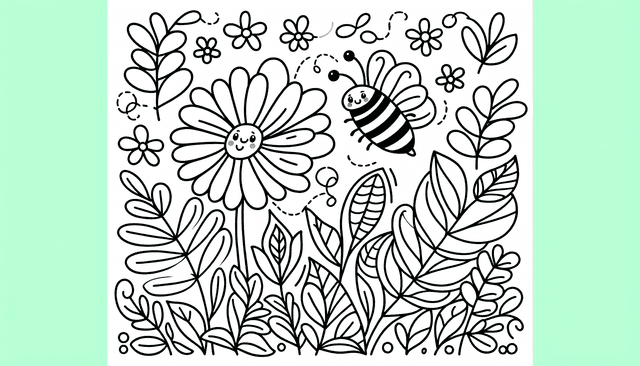Table of Contents
Publishing a coloring book can feel like a daunting task, especially if you’re unsure where to start. You might be wondering about the themes, illustrations, and all those pesky legal details. It’s totally normal to feel overwhelmed by the process of turning your creative vision into a tangible product.
But don’t worry! If you stick around, I’ll guide you through the ins and outs of publishing a coloring book, from picking that perfect theme to navigating distribution channels. You’ll soon discover that the journey can be both fun and rewarding!
In this guide, we’ll cover essential steps like choosing illustrations, formatting for print, and clever marketing strategies. Plus, I’ll share tips for designing pages that engage and excite your audience. Let’s dive in and unleash your inner artist!
Key Takeaways
- Start by choosing a unique theme for your coloring book that appeals to your target audience.
- Create or source engaging illustrations, ensuring you have the rights for any stock images you use.
- Format your book for printing, paying attention to size, margins, and file quality for a professional look.
- Select a printing method based on your budget and expected sales: print on demand or traditional printing.
- Design pages with clear lines and varied complexity to keep users engaged at different skill levels.
- Incorporate themes and storytelling elements for a cohesive and enriching coloring experience.
- Understand legal aspects like copyright, ISBNs, and licensing to protect your work and comply with regulations.

1. How to Publish a Coloring Book
Publishing a coloring book might seem like a daunting task, but breaking it down into manageable steps can make the process a breeze. By identifying your theme, sourcing or creating illustrations, formatting your book, and choosing a printing method, you can successfully bring your coloring book idea to life.
1.1 Choose Your Coloring Book Theme
The first step in publishing a coloring book is to settle on a theme. Popular ideas include animals, nature, mandalas, fantasy, or even educational concepts. Think about what excites you and what your potential audience might enjoy.
Consider your target market. Are you creating a coloring book for kids, adults, or a specific niche like mindfulness? Researching current trends or even checking bestseller lists can give you insights into what’s appealing to readers right now.
Finding a unique angle or niche can help differentiate your book from the many others out there. For example, instead of just a general floral coloring book, think about creating an enchanted garden theme that tells a story through each page.
1.2 Create or Source Illustrations
Once you have your theme, it’s time to get creative with illustrations. If you’re an artist, you can start sketching your designs, but if you’re not, you have several options to consider. You can hire an illustrator through platforms like Upwork or Fiverr.
Another option is to purchase stock illustrations specifically designed for coloring books. Websites like Etsy and Shutterstock have a wide array of creative options. Ensure that you have the appropriate rights to use the illustrations you choose.
Whether you create or source your illustrations, ensure they are engaging and align with the theme of your book. Clear outlines and interesting designs can make your coloring book more enjoyable for users.
1.3 Format Your Coloring Book for Printing
The formatting of your coloring book is crucial for a professional finish. Start by deciding on the size of your book. Common dimensions include 8.5 x 11 inches or 8 x 8 inches, but you can choose any size that fits your vision.
Make sure to consider margins and bleeds when creating your layout. Typically, a 0.125-inch bleed on all edges is recommended to ensure that your designs extend all the way to the edge of the page after printing.
Save your final files as high-resolution PDFs to ensure that they meet print specifications. Many print services provide guidelines, so check those before finalizing your design.
1.4 Select a Printing Method
Choosing the right printing method can make a significant difference in your book’s quality and cost. There are primarily two options: print on demand (POD) and traditional printing.
1.4.1 Print on Demand
Print on demand is a popular option, especially for first-time authors. With services like Amazon KDP or Lulu, you don’t need to invest in a large print run.
POD allows you to print copies as they are ordered, minimizing upfront costs and inventory risks. Plus, your book can be listed for sale online immediately after you publish.
1.4.2 Traditional Printing
If you expect to sell a large number of copies, traditional printing might be a more cost-effective approach. This involves printing a bulk quantity upfront, usually through offset printing.
While the initial investment is higher, the per-unit cost decreases significantly with larger print runs. Just be sure that you have a clear marketing strategy in place to move these books once they’re printed.

2. Tips for Designing Engaging Coloring Pages
Designing engaging coloring pages can make all the difference in how much people enjoy using your book.
2.1 Understand Your Target Audience
Before you start sketching, you need to know who you’re designing for.
Is it kids who love cartoons, or adults looking for intricate patterns?
Research your target demographics to tailor your artwork to their preferences.
Create a profile for your ideal customer, considering their age, interests, and experience with coloring.
This will guide the complexity and style of your designs.
For example, children’s pages should be less detailed and colorful, while adult pages can incorporate intricate designs and calming themes.
Polls, surveys, or social media discussions can also offer valuable insights about what potential users enjoy.
Remember, engaging content is all about understanding who will be using it.
2.2 Use Clear and Simple Lines
Great coloring pages start with clear and simple lines.
Your designs need to be easy to read at a glance and enjoyable to color in.
Use bold outlines to help guide the user’s pencil or marker smoothly within the shapes.
Avoid overly intricate patterns that can lead to frustration and make coloring less enjoyable.
If your target audience is younger children, simplicity is key.
For example, think about using clear, thick outlines for animal shapes or cartoon characters that can easily be filled in.
As you create your illustrations, step back and ask yourself if a beginner could easily navigate through the design.
2.3 Offer Varied Levels of Complexity
Including varied levels of complexity in your coloring pages ensures that you appeal to a broader audience.
A good rule of thumb is to provide pages with a mix of easy, medium, and difficult designs.
For instance, you could start the book with simpler pages and then build complexity, providing both instant gratification and a sense of challenge.
This way, users can choose their level of difficulty depending on their mood or skill level, offering something for everyone.
2.4 Include Themes and Concepts
Adding themes and concepts to your coloring pages can enhance their appeal and give a narrative to your book.
3. Legal Considerations for Publishing a Coloring Book
Understanding the legal landscape associated with publishing your coloring book is crucial to avoid potential pitfalls.
3.1 Copyright for Illustrations
First and foremost, copyright your illustrations.
3.2 ISBN and Barcodes
Obtaining an ISBN is essential for anyone serious about selling a coloring book.
3.3 Print Rights and Licensing
Finally, understand your print rights and any licensing agreements for illustrations.

4. Marketing Your Coloring Book
Marketing your coloring book is essential to ensure it reaches your audience and stands out in a crowded marketplace.
4.1 Build an Online Presence
Having a solid online presence is a must for authors today.
Create a professional website showcasing your coloring book, where visitors can learn about your work, see samples, and have links to purchase.
Consider starting a blog related to your theme, offering tips, coloring techniques, or behind-the-scenes insights into your creative process.
Engaging content helps to attract visitors and can turn casual visitors into potential buyers.
Don’t forget to optimize your website for search engines by using relevant keywords and regularly updating content.
4.2 Use Social Media for Promotion
Social media is a powerful tool for promoting your coloring book.
Platforms like Instagram and Pinterest are particularly effective as they focus on visual content.
Create eye-catching posts showcasing your illustrations, process videos, or completed colored pages.
Engage with your audience by asking them to share their own colored pages using a specific hashtag.
Consider running giveaways or contests to build excitement and gain followers.
4.3 Collaborate with Influencers and Bloggers
Partnering with influencers and bloggers can amplify your book’s reach.
Look for those who specialize in crafts, art, or parenting, depending on your target audience.
Reach out to them for potential collaborations, whether that’s sending a free copy for review or working together on a special project.
Influencers have established followers who trust their recommendations, making them powerful allies in your marketing efforts.
Don’t hesitate to craft a personalized pitch that clearly outlines how your coloring book aligns with their content.
Collaborations can be a win-win, offering valuable exposure for your book.
5. Pricing Your Coloring Book
Setting the right price for your coloring book is crucial for attracting buyers while also covering your costs.
5.1 Research Competitor Pricing
Start by examining the pricing trends of similar coloring books in your genre.
Take note of what competitors charge, the quality and dimensions of their books, and how their pricing might change depending on features like spiral binding.
List down the price points of several competitors to identify a range that feels appropriate for your book.
5.2 Determine Production Costs
Once you have a sense of competitor pricing, calculate your production costs to set a profitable price point.
Include costs associated with illustration, formatting, printing, and any marketing expenses.
Keep in mind that print-on-demand services have different costs compared to traditional printing, which can affect your final price.
5.3 Set a Price Point that Attracts Buyers
Your book’s price should be compelling enough to attract buyers without selling yourself short.
Consider using psychological pricing strategies, like pricing your coloring book at $9.99 instead of $10, to make it seem less expensive.
Sometimes offering a launch discount can generate initial sales momentum, encouraging early adopters to support your work.
Don’t forget to revisit your pricing strategy regularly based on feedback and sales performance.
6. Getting Feedback and Making Improvements
Receiving feedback from your audience can be a fantastic way to enhance your coloring book.
6.1 Gather Reviews from Early Readers
Before fully launching your book, consider giving out early copies to beta readers or a small group of loyal followers.
Encourage them to provide honest feedback about their experience with the book and the illustrations they found most compelling.
Reviews can be used as testimonials on your website or promotional materials, lending credibility to your project.
6.2 Make Adjustments for Future Editions
Use the feedback you’ve gathered to improve future editions of your coloring book.
Maybe they felt certain designs could use more detail or that additional themes would enhance their experience.
This iterative process not only improves your book but also helps retain customer loyalty, as people appreciate when creators listen to their audience.
7. Expanding Your Coloring Book Offerings
Once your first coloring book is out and gaining traction, it’s time to think about expanding your offerings.
7.1 Create Additional Volumes or Series
Consider creating a series of themed coloring books that build on the success of your first one.
This continuity can draw in repeat customers eager for the next installment.
For example, if your first book is about animals, the next could be about endangered species, combining art with education.
7.2 Offer Digital Versions and Printables
Digital coloring books are becoming increasingly popular, allowing for quick access and convenience.
Consider offering downloadable printables on your website so customers can print and color at home.
This option can also attract customers who may prefer digital platforms, expanding your potential audience.
7.3 Explore Licensing Opportunities for Other Products
Expand your brand further by exploring licensing opportunities for art designs.
Your illustrations can be used on merchandise such as stationery, apparel, or home decor.
Partnering with companies that align with your brand can tap into new markets while providing additional revenue streams.
Overall, think creatively about how your artwork can reach more people in various formats!
FAQs
Popular themes include nature, fantasy, mandalas, and animals. Consider your target audience’s interests to create engaging themes that appeal to their preferences and tastes.
You can choose between print on demand and traditional printing. Print on demand minimizes upfront costs, while traditional printing may provide a lower cost per unit for larger quantities.
Research competitor pricing and consider your production costs. Aim for a price point that is competitive yet attractive to potential buyers, ensuring you achieve your desired profit margins.
Key legal considerations include acquiring copyright for illustrations, obtaining an ISBN and barcode, and understanding print rights and licensing to protect your work and ensure compliance.



